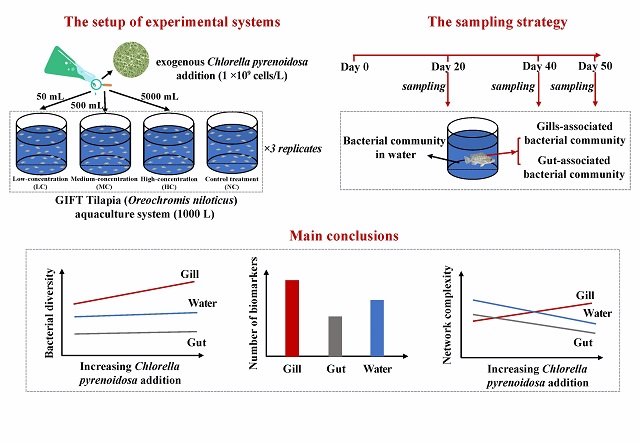
Microalgae have long been recognized for their potential to improve both water quality and fish growth in aquaculture systems. Their ability to serve as a natural and sustainable source of nutrients makes them a valuable asset to the industry.
However, despite their widespread use, our understanding of how microalgae affect the intricate network of microorganisms that govern water quality and fish health in aquaculture environments remains limited.
On the other hand, various studies have reported that microalgae can effectively enhance the immune function and growth of aquatic animals, thereby increasing aquaculture efficiency.
In an innovative 50-day mesocosm experiment, researchers from the Freshwater Fisheries Research Center and Nanjing Agricultural University attempted to shed light on the effects of Chlorella pyrenoidosa microalgae on the microbial communities associated with aquaculture water, the gills, and the intestines of tilapia.
This research aimed to explore the potential impacts of adding microalgae to these critical factors and their implications for fish health and water quality in aquaculture systems.
Mesocosm Experiment
The study simulated the cultivation of genetically improved tilapia (GIFT, Oreochromis niloticus), with an average weight of 14.18 ± 0.93 grams and an average length of 82.77 ± 2.80 millimeters.
Various amounts of Chlorella pyrenoidosa were introduced into these aquaculture systems, allowing researchers to observe how the addition of this microalgae influenced the microbial communities within the system.
Gill-Associated Bacterial Communities
One of the most notable findings was the substantial impact of Chlorella pyrenoidosa on the gill-associated bacterial communities. The addition of this microalgae resulted in increased diversity and complexity in the network of these bacterial communities.
Stay Always Informed
Join our communities to instantly receive the most important news, reports, and analysis from the aquaculture industry.
“There was a growing trend in alpha diversity of gill-associated bacterial communities in response to increasing Chlorella pyrenoidosa addition. Similarly, the number and percentage of unique OTUs increased in gill-associated bacterial communities with the addition of Chlorella pyrenoidosa,” the scientists reported.
This suggests that fish gills, where the aquatic environment directly interacts with the fish’s body, are particularly sensitive to changes in the microbiota.
The results suggested that “the presence of Chlorella pyrenoidosa could be beneficial in increasing the diversity of gill-associated bacterial communities by promoting both new colonizers and enriching dominant local taxa in fish gills simultaneously.”
Sensitivity of Gill-Associated Microbiota
The study also revealed that more biomarkers in gill-associated bacterial communities responded to the addition of Chlorella pyrenoidosa compared to water and fish intestine samples.
This high sensitivity of gill-associated bacterial communities to the presence of microalgae indicates the important role that Chlorella pyrenoidosa can play in regulating mucosal immunity in fish by altering the gill microbiota.
Implications for GIFT Tilapia Aquaculture
These findings suggest that microalgae, such as Chlorella pyrenoidosa, can be used not only to improve water quality and fish growth but also to actively contribute to the regulation of fish health by modifying the gill-associated microbiota.
Conclusion
In conclusion, this study provides valuable insights into the intricate relationship between microalgae, microbial communities, and fish health in aquaculture.
“Our results showed that the addition of Chlorella pyrenoidosa exhibited distinct influences on bacterial communities between water, fish gills, and intestines. As Chlorella pyrenoidosa addition increased, the number of unique OTUs in gill-associated bacterial communities increased significantly, leading to a notable increase in the richness of gill-associated bacterial communities,” the researchers concluded.
They emphasized that the most significant impact of adding Chlorella pyrenoidosa was observed in the bacterial community associated with fish gills. “The increase in bacterial diversity, changes in community composition, and increased network complexity as a result of C. pyrenoidosa addition may have implications for the mucosal immune function of tilapia gills,” the researchers concluded.
The study was funded by CARS, Central Public-interest Scientific Institution Basal Research Fund, Freshwater Fisheries Research Center, CAFS, and Project of Kunshan Yangcheng Lake Crab Industrial Research Institute.
Reference (open access)
Meng, S.; Xu, H.; Qin, L.; Chen, X.; Qiu, L.; Li, D.; Song, C.; Fan, L.; Hu, G.; Xu, P. The Gill-Associated Bacterial Community Is More Affected by Exogenous Chlorella pyrenoidosa Addition than the Bacterial Communities of Water and Fish Gut in GIFT Tilapia (Oreochromis niloticus) Aquaculture System. Biology 2023, 12, 1209. https://doi.org/10.3390/biology12091209
Editor at the digital magazine AquaHoy. He holds a degree in Aquaculture Biology from the National University of Santa (UNS) and a Master’s degree in Science and Innovation Management from the Polytechnic University of Valencia, with postgraduate diplomas in Business Innovation and Innovation Management. He possesses extensive experience in the aquaculture and fisheries sector, having led the Fisheries Innovation Unit of the National Program for Innovation in Fisheries and Aquaculture (PNIPA). He has served as a senior consultant in technology watch, an innovation project formulator and advisor, and a lecturer at UNS. He is a member of the Peruvian College of Biologists and was recognized by the World Aquaculture Society (WAS) in 2016 for his contribution to aquaculture.




